Altcoin exchanges have gained popularity due to their low trading fees, often ranging from 0.1% to 0.2%, which appeals to both novice and experienced traders. User experience plays a crucial role in these platforms, with intuitive designs and responsive customer support enhancing overall satisfaction. Additionally, robust security measures, including two-factor authentication and cold storage, are essential for safeguarding user assets in the volatile world of cryptocurrency trading.
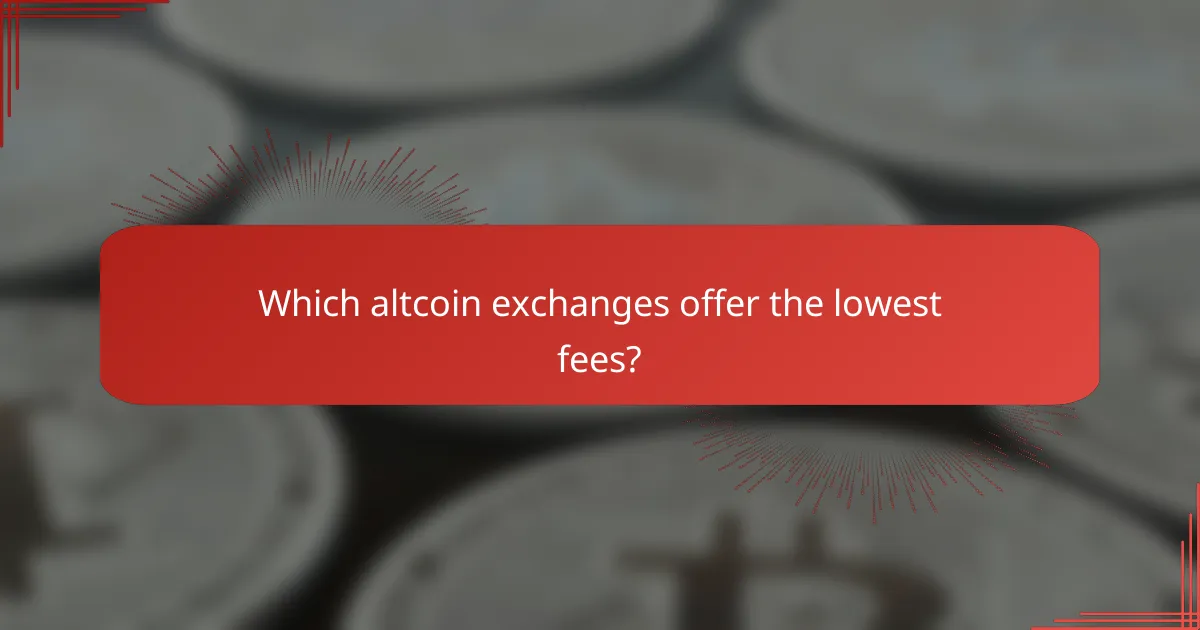
Which altcoin exchanges offer the lowest fees?
Several altcoin exchanges are known for their low trading fees, making them attractive options for traders. Platforms like Binance, KuCoin, and Bitfinex typically offer competitive rates, often in the range of 0.1% to 0.2% per trade, depending on the trading volume and specific conditions.
Binance
Binance is one of the largest cryptocurrency exchanges globally, offering a tiered fee structure that rewards high-volume traders with lower fees. Standard trading fees start at 0.1%, but users can reduce this further by using Binance Coin (BNB) to pay for fees, potentially lowering them to 0.075%.
Additionally, Binance offers various trading pairs and features like futures and margin trading, which can also affect the overall cost of trading. Always check the fee schedule on their website for the most current rates and promotions.
KuCoin
KuCoin is another popular exchange known for its low trading fees, typically around 0.1% for both makers and takers. The platform also has a unique feature called KuCoin Shares (KCS), which allows users to earn a share of the trading fees generated on the platform, effectively reducing costs further.
KuCoin frequently runs promotions that can lower fees even more, so it’s beneficial to keep an eye on their announcements. The exchange supports a wide variety of altcoins, making it a versatile choice for traders looking to diversify their portfolios.
Bitfinex
Bitfinex offers a fee structure that starts at 0.1% for makers and 0.2% for takers, with discounts available for high-volume traders. The platform is particularly favored by professional traders due to its advanced trading features and liquidity.
While Bitfinex’s fees are competitive, it’s essential to consider the platform’s security measures and regulatory status, as they have faced scrutiny in the past. Always review the latest fee schedule and terms before trading.
Kraken
Kraken is well-regarded for its security and user-friendly interface, with trading fees starting at 0.16% for takers and 0.0% for makers, which can decrease with higher trading volumes. This makes it an attractive option for both new and experienced traders.
Kraken also offers various fiat currency pairs, which can be advantageous for users looking to trade directly with their local currency. Be sure to check their fee schedule for any updates or changes based on your trading activity.
Gemini
Gemini is known for its regulatory compliance and security features, with trading fees typically around 0.35% for takers and 0.25% for makers. While these fees are slightly higher than some competitors, the platform’s reputation for safety can justify the cost for many users.
Gemini also offers a user-friendly interface and a mobile app, making it accessible for beginners. Users should consider the overall value of security and ease of use when evaluating Gemini’s fees against other exchanges.
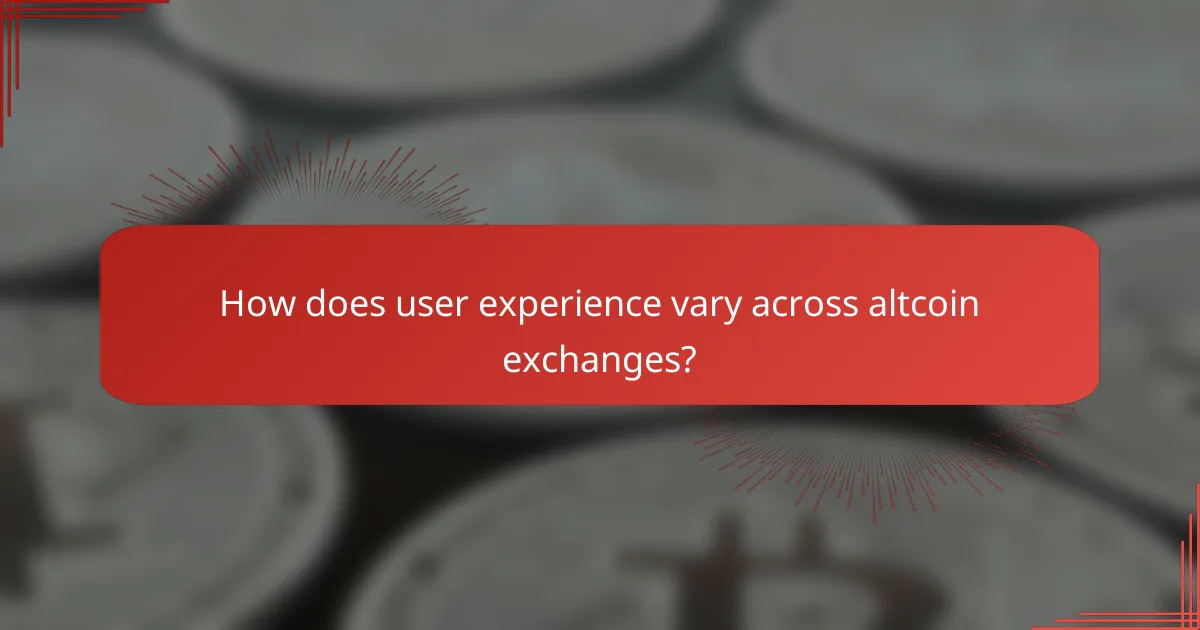
How does user experience vary across altcoin exchanges?
User experience on altcoin exchanges can differ significantly based on factors like interface design, ease of navigation, and customer support. A well-designed platform enhances trading efficiency, while responsive support can resolve issues quickly, making a substantial difference in user satisfaction.
Coinbase
Coinbase is known for its user-friendly interface, making it an excellent choice for beginners. The platform offers a straightforward sign-up process and intuitive navigation, allowing users to buy, sell, and store various altcoins with ease.
However, Coinbase tends to have higher fees compared to other exchanges, particularly for smaller transactions. Users should be aware of these costs and consider using Coinbase Pro for lower fees if they are comfortable with a more complex interface.
Binance
Binance provides a robust trading platform with a wide selection of altcoins and competitive fees. The user experience is enhanced by advanced trading tools, charts, and a customizable interface that caters to both novice and experienced traders.
While Binance offers a comprehensive experience, new users may find the initial learning curve steep. It is advisable to explore the platform’s educational resources and start with basic trades before diving into more complex transactions.
Bitstamp
Bitstamp is recognized for its reliability and security, appealing to users who prioritize safety. The platform features a clean interface and offers a solid selection of altcoins, although it may not have as many options as larger exchanges like Binance.
Bitstamp’s fees are moderate, and it provides a transparent fee structure. Users should consider the withdrawal fees, which can vary based on the currency, and ensure they understand the costs involved before trading.
Huobi
Huobi offers a diverse range of altcoins and is known for its advanced trading features, including margin trading and various order types. The user experience is generally positive, with a well-organized layout and responsive customer support.
However, Huobi’s interface may be overwhelming for beginners due to its extensive features. New users should take advantage of Huobi’s demo trading options to familiarize themselves with the platform before committing real funds.
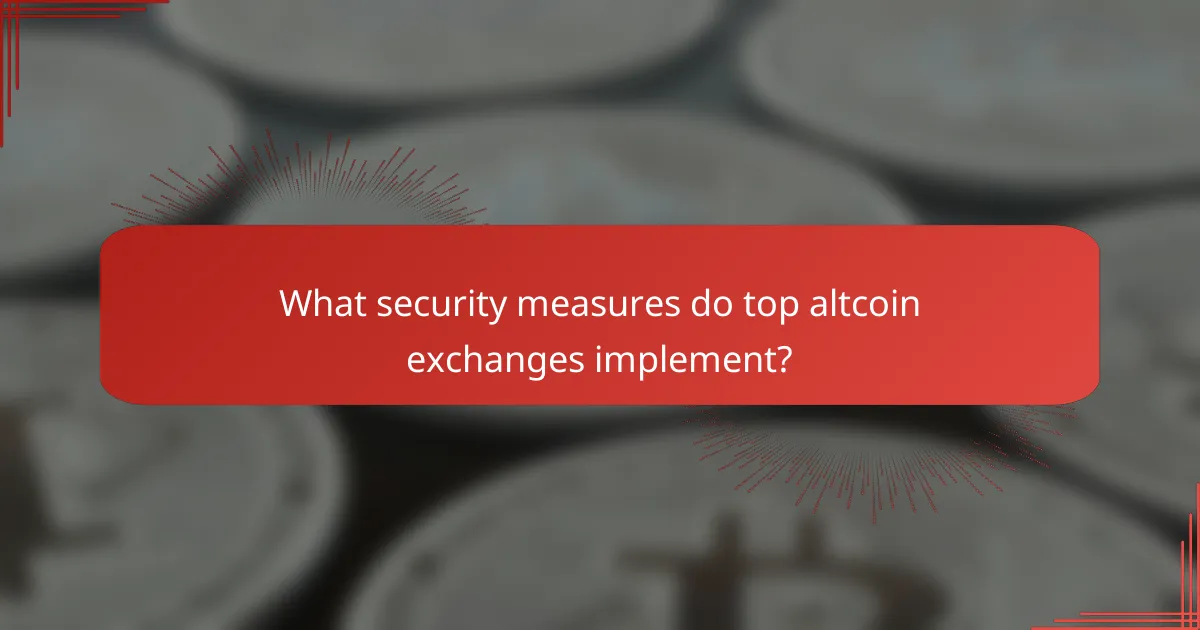
What security measures do top altcoin exchanges implement?
Top altcoin exchanges implement various security measures to protect user assets and data. Key strategies include two-factor authentication, cold storage solutions, and insurance policies, all aimed at minimizing risks associated with trading cryptocurrencies.
Two-factor authentication
Two-factor authentication (2FA) adds an extra layer of security by requiring users to verify their identity through a second method, typically via a mobile app or SMS. This means even if a hacker obtains your password, they cannot access your account without the second factor. It’s advisable to use apps like Google Authenticator or Authy for enhanced security over SMS.
Cold storage solutions
Cold storage refers to keeping the majority of a cryptocurrency exchange’s assets offline, significantly reducing the risk of hacking. Many exchanges store funds in hardware wallets or other secure offline methods. Users should check if their chosen exchange employs cold storage and what percentage of assets are kept this way, as this can vary widely.
Insurance policies
Some exchanges offer insurance policies to cover losses from hacks or breaches, providing an additional safety net for users. While not all exchanges have such policies, those that do often specify the coverage limits and conditions. It’s important to read the terms carefully to understand what is protected and under what circumstances.
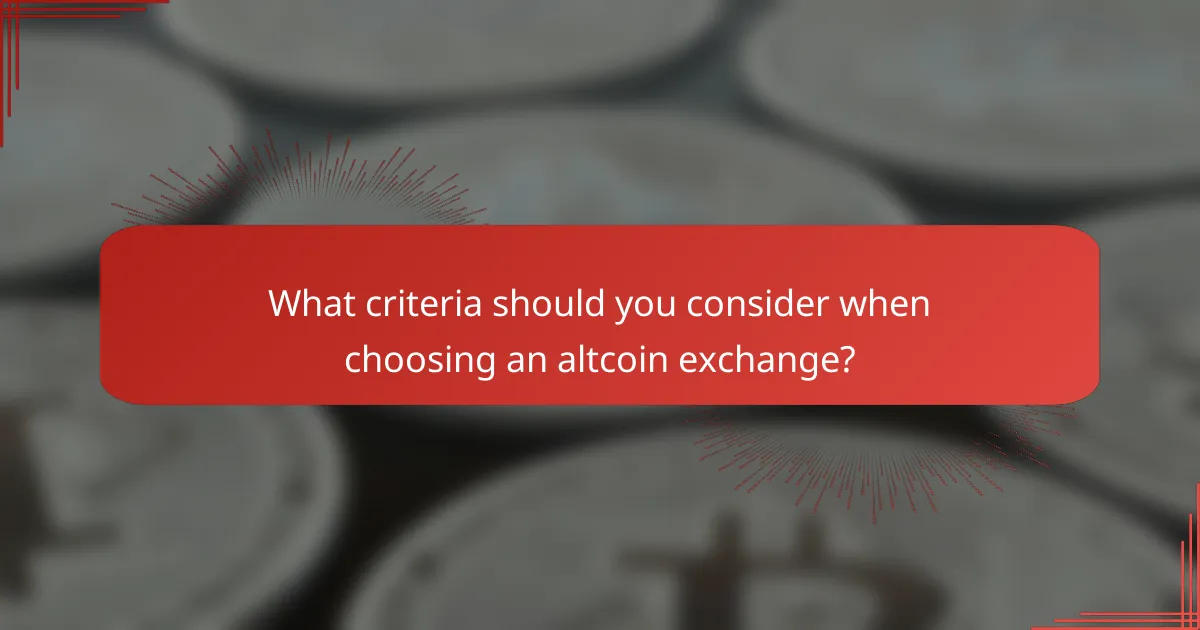
What criteria should you consider when choosing an altcoin exchange?
When selecting an altcoin exchange, focus on three main criteria: fee structure, user interface, and security features. These factors significantly impact your trading experience and overall satisfaction with the platform.
Fee structure
The fee structure of an altcoin exchange can vary widely, affecting your overall trading costs. Look for exchanges that offer competitive trading fees, typically ranging from 0.1% to 0.5% per transaction. Some platforms may also charge withdrawal fees, so it’s essential to review these costs before committing.
Consider whether the exchange has a tiered fee system based on your trading volume, as this can lead to lower fees for frequent traders. Additionally, some exchanges offer fee discounts for using their native tokens, which can further reduce costs.
User interface
A user-friendly interface is crucial for a smooth trading experience, especially for beginners. Look for exchanges that provide intuitive navigation, clear charts, and easy access to trading pairs. A well-designed platform can help you execute trades more efficiently and reduce the likelihood of errors.
Many exchanges offer demo accounts or tutorials that allow you to familiarize yourself with their interface before trading with real money. Take advantage of these resources to find a platform that suits your trading style and preferences.
Security features
Security is paramount when choosing an altcoin exchange, as the risk of hacking and fraud is prevalent in the cryptocurrency space. Look for exchanges that implement robust security measures, such as two-factor authentication (2FA), cold storage for funds, and regular security audits.
Additionally, check if the exchange has a history of security breaches and how they responded to any incidents. A transparent approach to security can indicate a trustworthy platform. Always ensure that the exchange complies with local regulations and has a good reputation in the crypto community.
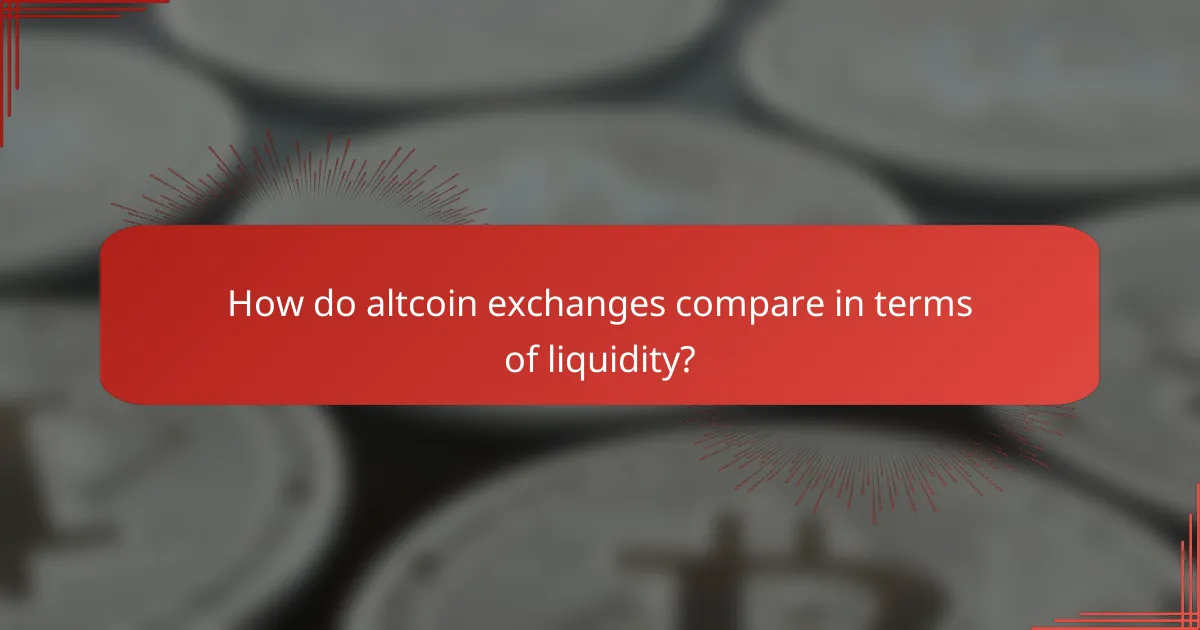
How do altcoin exchanges compare in terms of liquidity?
Liquidity on altcoin exchanges refers to how easily assets can be bought or sold without significantly affecting their price. High liquidity is essential for traders as it allows for quicker transactions and better pricing.
Understanding Liquidity in Altcoin Exchanges
Liquidity in altcoin exchanges is determined by the volume of trades and the number of active users. Exchanges with higher trading volumes typically offer better liquidity, enabling users to execute trades swiftly and at more favorable prices. Factors such as market demand and the number of trading pairs also play a crucial role.
Factors Affecting Liquidity
Several factors influence liquidity on altcoin exchanges. Key among them are the exchange’s reputation, the number of listed altcoins, and the trading fees. For instance, well-established exchanges like Binance or Coinbase generally have higher liquidity compared to newer or less-known platforms.
Assessing Liquidity Before Trading
Before trading on an altcoin exchange, assess its liquidity by checking the trading volume for specific altcoins. Look for exchanges that display real-time trading data and have a history of consistent user activity. Avoid platforms with low trading volumes, as they may lead to slippage and unfavorable pricing.


